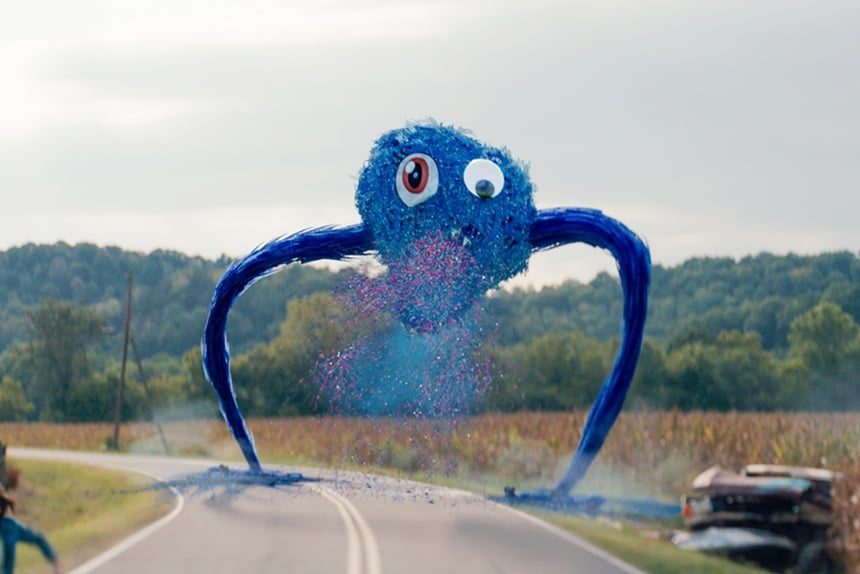
Sketch
⭐️ ⭐️ ⭐️ ⭐️ ⭐️
Rating: PG
Run Time: 1 hour 32 minutes
Stars: Tony Hale, Bianca Belle, Kue Lawrence
Writer/Director: Seth Worley
Reviewed at the Toronto International Film Festival
In a year that has seen its share of visionary future classics (Sinners and The Life of Chuck among them, for my money), there is just one movie I have willingly watched three times, and would gladly sit through again: a funny, imaginative, bravely sentimental horror movie about a little girl whose drawings of fanciful monsters come to life.
In Sketch, first-time feature writer/director Seth Worley conjures up a miracle of cinematic alchemy, improbably blending elements of Alien, Cloverfield, and Carrie with shards of The Goonies, Who Framed Roger Rabbit? and Harold and the Purple Crayon — adding shoutouts to Psycho and North by Northwest for good measure.
And it works. Boy, does it work.
Young middle schooler Amber (dark-eyed Bianca Belle) is deeply saddened by the recent death of her mother. So are her dad, Taylor (Arrested Development’s Tony Hale) and brother, Jack (Kue Lawrence). But while Amber is channeling her grief by acting up at school and drawing pictures of scary monsters, the two guys are clearly trying to gut it out, barely mentioning the recent tragedy.
It’s a somber setup for a movie, but Worley has no patience for easy sentiment: At the dinner table, Amber and Jack openly muse about whether or not they can now be considered orphans.
“No!” their exasperated dad protests. “I’m right here!”
The kids are unfazed: What do you call a kid whose mother has died?
“A morphan,” Amber suggests.
And like that, the label sticks.
Taylor’s chief concern these days is his daughter’s increasingly sinister artwork: crayon drawings of beasts that suck out victims’ blood and then vomit the blood; an enormous blue monster with swords for toes, so he can crush his victims to death and then slice them up for good measure; a blind maneater that is always accompanied by a small creature that emits a siren-like squeal when food is nearby.
And then there are the “eye-ders,” eyeballs with spider-like legs, that overwhelm their victims through sheer numbers.
But mostly, there’s a deathly dark-purple humanoid, cloaked in a cowl-like hoodie, with dagger-like hands. It is Amber’s drawing of that creation—stabbing a classmate in the stomach—that gets Taylor and her dad summoned to the school psychologist’s office.
Hale, a fine comic actor whose sense of undefined melancholy has always enriched his work, plays the scene with pitch-perfect parental bewilderment.
“Well,” he finally acknowledges, “that is a lot of blood.”
Fully understanding the depths of Amber’s distress, her doctor presents her with a spiral notebook, encouraging her to keep drawing monsters as a way to deal with her sadness. Amber is on board immediately: She snatches the book and, glancing around, demands, “Do you have any crayons?”
Just how Amber’s monster-filled notebook ends up getting dunked into a magical pond that brings them all to life is, thankfully, explained away with efficient dispatch. Writer Worley knows there’s no sense in cramming the square peg of fantasy into the round hole of reality — no labored explanations, à la Star Wars’ Jedi-creating midi-chlorian blood supplements, here. The pond is magic. The pictures come to life. There. Done.
What follows is the realization of a child’s dark phantasm: In town, across the surrounding farmland, in the deepest nearby forests, Amber’s sparkly, glittery, crayon-and-marker creations wreak havoc in ways that recall, in equal measures of shock and delight, the climactic citywide rampage of Ghostbusters (did I forget to mention Ghostbusters?).
In a movie that gets just about everything right, the realization of Amber’s monsters is Sketch’s standout achievement: Computer graphics chief J. Alan Bradshaw (Percy Jackson and the Olympians) ingeniously approximates the indistinct style of a child’s artwork, and maintains it even at full rampage. In any other context, nearly all the monsters in Sketch would be irresistibly cuddly — but as we all learned in Gremlins (oh yeah — Gremlins!) the line between cuteness and carnage can be thin indeed.
Composer Cody Fry has done his horror soundtrack research well: Not one opportunity for a musical “sting” goes unclaimed; He and Worley — who also edited — collaborate to create a sense of playful dread that evolves from beginning to end.
I can assure you that Sketch has a happy ending, one that accomplishes the magical feat of inducing sentimental tears and, simultaneously, uproarious laughter. (At a screening during last year’s Toronto International Film Festival, a theater full of hardened film critics greeted the closing credits with a burst of spontaneous applause.) But the lessons of the film are learned the hard way: Parenting is necessarily uncomfortable; childing is more treacherous than any grownup is willing to remember; sorrow is an equal-opportunity antagonist, but it can be beaten (if not vanquished) only if you meet it head-on.
See Sketch with your kids or grandkids. Laugh with them at the butt jokes. Scream with them at the roller coaster-like thrills.
And on the way home from the theater, stop to buy them some notebooks.
Become a Saturday Evening Post member and enjoy unlimited access.
Subscribe now
Source link

